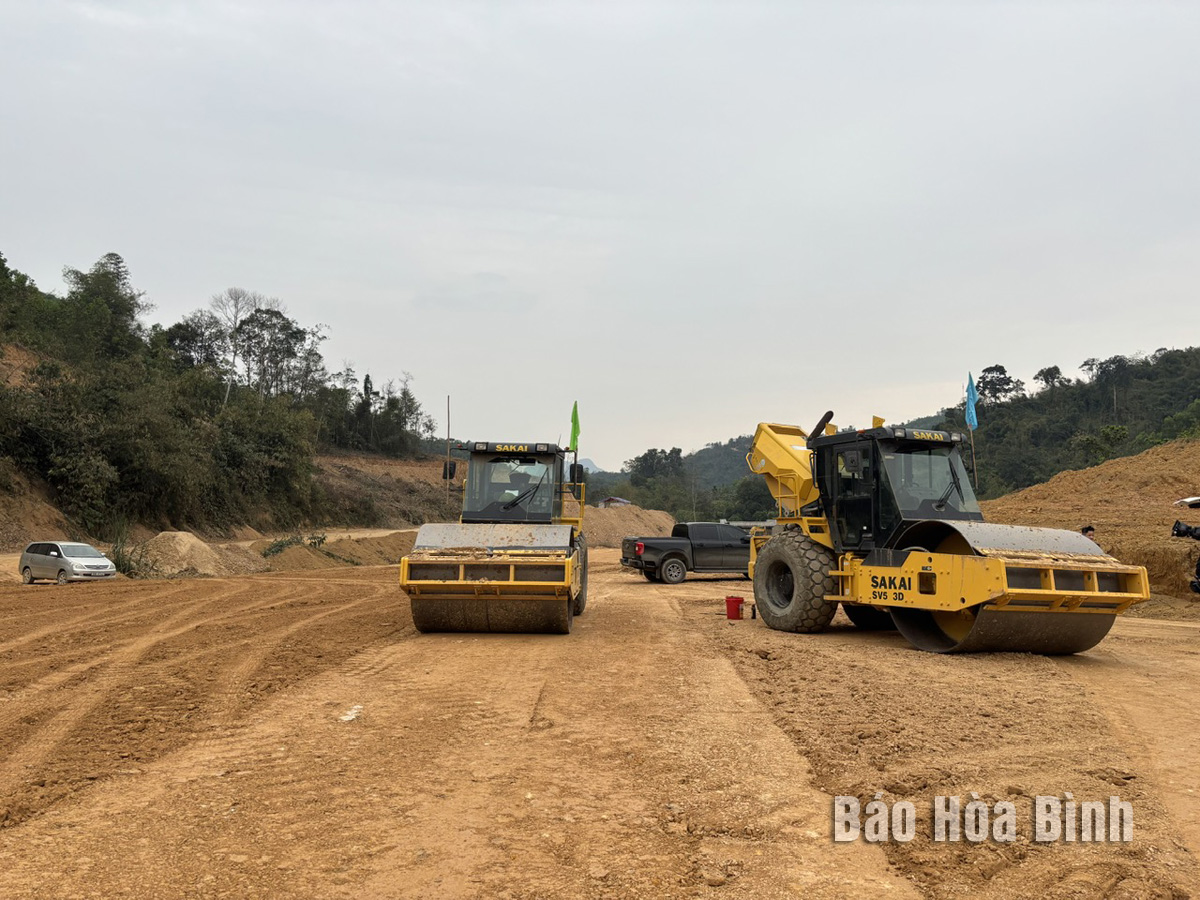
Hoa Binh province’s economy posted an impressive Gross Regional Domestic Product (GRDP) growth rate of 12.67% in the first quarter of 2025, representing a 12.76% year-on-year increase, the highest rate recorded since the beginning of the current tenure, according to the provincial Statistics Office. This robust growth reflects years of strategic groundwork and sets a strong foundation for the province’s annual growth target of over 10%.
The implementation of key projects has contributed to promoting the province's economic growth. Photo: Construction of a road which passes through Cao Son commune (Luong Son district) is underway.
By sector, the industry and construction segment led the way, expanding by
27.18% and contributing 9.92 percentage points to the overall growth. Within
this, industrial output alone surged by 33.1%, accounting for 9.4 percentage
points. Meanwhile, the agro-forestry and fisheries sector grew by 4.19%
year-on-year, contributing 0.76 percentage points, and the services sector
expanded by 5.91%, adding 2.37 percentage points.
The service sector, which makes up about 34.6% of the province’s GRDP, received
a significant boost thanks to the launch of new tourism destinations. The
province has made key investments in port infrastructure and road systems
surrounding the Hoa Binh Lake tourist site, while also restoring cultural and
historical landmarks to attract more visitors. These developments have also
driven notable growth in related industries: wholesale and retail trade
increased by 8.93%, accommodation and food services by 17.36%, and
transportation by 21.09%.
Although Q1 marks the beginning of a new agricultural crop, high-efficiency
production models and value chains continued to thrive. Authorities have also
maintained a strong focus on ensuring food safety and the quality of
agricultural inputs. Hoa Binh currently boasts 158 One Commune One Product
(OCOP) items rated between 3 and 4 stars, including seven products that have
been shipped abroad, further bolstering the province’s agricultural output.
Nguyen Khanh Son, deputy head of the provincial Statistics Office, emphasised
that this strong performance was not a short-term spike but rather the result
of sustained, long-term planning and consistent effort.
Hoa Binh aims to achieve a minimum growth rate of 10% in 2025, surpassing the
national target. To meet this goal, provincial authorities have instructed
departments and localities to conduct thorough assessments, enhance forecasting
capabilities, and deploy timely and effective solutions.
Key measures include accelerating investment in transport, industrial park
infrastructure, and digital transformation, while assigning clear growth
targets to each sector and locality with specific quarterly and biannual scenarios.
Building on the momentum from Q1, Hoa Binh anticipates strong growth in Q2 as
well. The province plans to commence several major projects, including the Xuan
Thien Hoa Binh lime and light powder production plant, new golf courses and
urban development projects in Luong Son district and Hoa Binh city, and a
large-scale eco-tourism and resort complex by Sun Group. At the same time,
local authority will continue to roll out measures to stimulate domestic
consumption, renew trade promotion activities, and ramp up export efforts,
particularly targeting key international markets.
However, Son also acknowledged several ongoing challenges.
External factors, such as US tariff policies, have negatively impacted export
performance. Meanwhile, delays in land clearance, public investment
disbursement, and the implementation of national target programmes remain
obstacles to sustained economic progress.
To maintain growth momentum, he stressed the need to further improve the local
business climate, attract more investment, and accelerate the development of
the processing and manufacturing industries. Continued support for agriculture
and services will also be essential, along with bold and timely actions to
resolve bottlenecks and fast-track public investment, especially for large-scale
and strategic provincial projects, Son added.
According to data from the Hoa Binh Provincial Party Committee, the industrial production index for the first six months of 2025 is estimated to have increased by 20% compared to the same period last year. This marks the highest year-on-year growth rate for this period since 2020.
In the first six months of 2025, Hoa Binh province’s export turnover was estimated at 1.145 billion USD, marking an 18.11% increase compared to the same period in 2024. Import turnover was estimated at $ 804 million, a 17.15% increase, which helped the province maintain a positive trade balance.
The lives of the ethnic minority farmers in Tan Lac district have gradually improved thanks to the new directions in agricultural production. This is a testament to the collective strength fostered through the professional associations and groups implemented by various levels of the district’s Farmers’ Union.
With the motto the "product quality comes first,” after nearly one year of establishment and operation, Muong village’s Clean Food Agricultural and Commercial Cooperative, located in Cau Hamlet, Hung Son Commune (Kim Boi district), has launched reputable, high-quality agricultural products to the market that are well-received by consumers. The products such as Muong village’s pork sausage, salt-cured chicken, and salt-cured pork hocks have gradually carved out a place in the market and they are on the path to obtaining the OCOP certification.
In the past, the phrase "bumper harvest, rock-bottom prices" was a familiar refrain for Vietnamese farmers engaged in fragmented, small-scale agriculture. But today, a new spirit is emerging across rural areas of Hoa Binh province - one of collaboration, organisation, and collective economic models that provide a stable foundation for production.
Maintaining growing area codes and packing facility codes in accordance with regulations is a mandatory requirement for agricultural products to be eligible for export. Recently, the Department of Agriculture and Environment of Hoa Binh province has intensified technical supervision of designated farming areas and packing facilities to safeguard the "green passport" that enables its products to access international markets.



